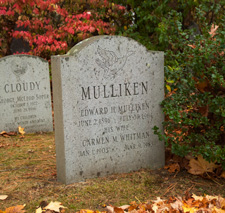Edward "Ted" Mulliken
[From a Shoreline Times articled dated 11/7/13 by Tedd Levy of the Old Saybrook Historical Society]

If it looks like a duck, but doesn’t quack like a duck, there’s a good chance it’s a decoy, and the phony creature may have come from the Wildfowler Decoy Company that thrived in Old Saybrook from 1939 until it was destroyed by a nightime fire in 1957.
In the first half of the 20th-century, duck hunting was very popular in Saybrook. Visitors would arrive at Saybrook Junction, walk to the Saye and Sele Inn about 100 yards away, and then hire nearby transportation to take them to the salt meadows along North and South Cove and along the Connecticut River where duck blinds were waiting.
Locals, too, enjoyed the sport, and one lifelong resident remembers how he and his friends brought their shotguns to school and then went duck hunting in the afternoon. Yeah, times have changed.

Several companies in Connecticut made decoys. The most important one in Saybrook was the Wildfowler Decoy Company begun by Edward “Ted” Mulliken (1896-1964, photo at left with his wife Carmen; Carmen is seen painting decoys below). His decoys became widely known because he made a wide-ranging variety of reasonably priced, realistic, flat-bottom decoys that remained stable in rough water. Decoy Magazine has an interesting write-up on Mulliken's Wildfowler Decoy Company.
Mulliken was a World War I veteran who was stationed in the Pensacola Naval Air Station and an avid duck shooter. When he returned home, he began making decoys in his garage. He spent his spare time with other decoy makers but traveled to a real estate job in the financial district in New York City.

On weekends, he continued making decoys with his hunting partner George Morris, who owned the Dauntless Shipyard in Essex. He was given space in the shipyard, and with a lathe and scrap wood made decoys there. From 1931 to 1934, the decoys were advertised in national magazines and well received. A dozen could be had for $36.
In the mid-1930s he began a game farm and hunting club, where he raised pheasants and turkeys at the end of Ingham Hill Road on land known today as “The Preserve.” The Hurricane of 1938 destroyed most of his pens, and the following year he returned to making decoys by opening a business that he called Wildfowler Decoys.
Just as humans are social animals, so, too, are ducks. But, when they fly in to join others, their anticipated social contact can be deadly. It’s pretty clear that the duck world has never communicated information about the danger of fake fowls to the next generation.

Duck and goose decoys were used hundreds of years ago by Native Americans, who made them out of rushes and reeds. In the 19th century, hunters used them along with duck calls to attract waterfowl to hunting blinds. The decoys were hand carved and painted to be realistic representations of various species including mallards, black ducks, bluebill ducks, canvasbacks and others. Mallards are the most friendly and social ducks and therefore the most commonly used decoy.

Older hand-carved decoys are collected as folk art and displayed on mantels rather than in the water. Values range from under $50 to $500, and notable rarities have brought
hundreds of thousands of dollars at auction.
Ted Mulliken and his wife Carmen are buried in Cypress Cemetery along the rear fence line in the southwest corner of the property. In the photo at left, there is a carving of the flying duck on the top of their marker (photo, right), commemorating their life work and passion.





